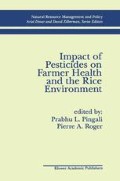Abstract
Agricultural productivity has increased substantially in the last half century due in part to the introduction and expanded use of agricultural chemicals. More recently, however, some agricultural practices including those associated with pesticide and fertilizer use have been viewed as having a major impact on the ecosystem and as being sources of environmental pollution and human health problems. Concern with the potential linkages among human health, environmental quality, and agricultural productivity reflects the growing demand by the general public and the international donor community for researchers to recognize the social benefits and social costs of agricultural technology and to address the long-run sustainability of existing agricultural practices.
Access this chapter
Tax calculation will be finalised at checkout
Purchases are for personal use only
Preview
Unable to display preview. Download preview PDF.
References
Antle, J.M., and R.E. Just. 1991. Effects of commodity program structure on resource use and the environment. In N. Bockstad and R. Just (eds.), In Commodity and Resource Policy in Agricultural Systems. New York: Springer-Verlag.
Antle, J.M., and P. Pingali. 1993. Pesticides, productivity, and farmer health: A Philippine case study. American Journal of Agricultural Economics 76 (August 1994): 418–430.
Bear, J., and A. Verruijt. 1987. Modeling groundwater flow and pollution. Dordrecht, Holland: D. Reidel.
Campen, J.T. 1986. Benefit, cost,and beyond. Cambridge, Mass., USA: Ballinger.
Farrell, K.R., and S.M. Capalbo. 1986. Natural resource and environmental dimensions of agricultural development. In Agriculture in a Turbulent World: Proceedings of the nineteenth International Conference of Agricultural Economists. Broomfield, Vt., USA: Grower.
Freeman, M. 1979. The benefits of environmental improvement. Washington, D.C.: Resources for the Future.
Gough, M. 1989. What does epidemiology tell us about relationships between environmental exposure to pesticides and disease? Washington, D.C.: Center for Risk Management, Resources for the Future.
Halvorsen, R., and M. Ruby. 1981. Benefit-cost analysis of air pollution control. Lexington, Mass., USA: Lexington Books.
Hartwick, J.M. 1991. Degradation of environmental capital and national accounting procedures. European Economic Review 35(199): 642–649.
Jury, W.A., D. Focht, and W.J. Farmer. 1987. Evaluation of pesticide groundwater pollution potential from standard indices of soil-chemical adsorption and biodegradation. Journal of Environmental Quality 16(4): 422–428.
Leavesley, G.H., D.B. Beasley, H.B. Pionke, and R.A. Leonard. 1989. Modeling of agricultural non-point source surface runoff and sediment yield—a review from a modeler’s perspective. Unpublished paper presented at the GLEAMS symposium, Athens Georgia, September 20–23.
Lyman, J.K., and R.W. Herdt. 1989. Sense and sustainability: Sustainability as an objec-tive in international agricultural research. Agricultural Economics 3: 381–398.
Mackay, D., S. Paterson, B. Cheung, and W.B. Neily. 1985. Evaluating the environmental behavior of chemicals using a level III fugacity model. Chemosphere 14: 335–374.
Mitchell, R.C., and R.T. Carson. 1989. Using surveys to value public goods: The contingent valuation approach. Washington, D.C.: Resources for the Future.
Nash, R.G. 1980. Dissipation rate of pesticides from soils. In W.G. Knisel (ed.), CREAMS: A Field-Scale Model for Chemicals,Runoff, and Erosion from Agricultural Management Systems. Vol. 3 (pp. 560–594). USDA Conserv. Res. Rep. 26.
Nash, R.G. 1988. Methods for estimating pesticide dissipation from soils. Supporting documentation for the small watershed model (SWAM). United States Department of Agriculture, Agricultural Research Service publication, 334–2693, Beltsville, MD.
Pingali, P.L., C.B. Marquez, and F.G. Palis. 1994. Health costs of long-term pesticide exposure in the Philippines: A medical and economic analysis. American Journal of Agricultural Economics 76 (August 1994): 587–592.
Rao, P.S., and J.M. Davidson. 1980. Estimation of pesticide retention and transformation parameters required in nonpoint source pollution models. In M.R. Overcash and J.M. Davidson (eds.). Environmental Impact of Nonpoint Source Pollution. Ann Arbor, Mi.: Ann Arbor Science Pub. Inc.
Rao, P.S., A.G. Hornsby, and R.E. Jessup. 1985. Indices for ranking the potential for pesticide contamination of groundwater. Proceeding of the Soil and Crop Science Society of Florida 44: 1–8.
Raucher, R. 1983. A conceptual framework for measuring the benefits of groundwater protection. Water Resources Research 19(2): 320–326.
Rutledge, A.T., and J.O. Helgesen. 1989. A steady state unsaturated zone model to simulate pesticide transport. Unpublished manuscript.
Smith, V.K. (ed). 1984. Environmental policy under Reagan’s Executive Order: The role of benefit-cost analysis. Chapel Hill, N.C., USA: University of North Carolina Press.
Smith, V.K., and W.H. Desvousges, 1985. The generalized travel cost model and water quality benefits: a reconsideration. Southern Economic Journal 52(2): 371–381.
Smith, R.E., and V.A. Ferreira. 1987. Simulating interrelations of chemical, soil, and hydrologic factors in pesticide runoff. Paper presented at the Symposium on the Surface Runoff of Chemicals from Agricultural Watersheds, April, Denver, Colorado.
Solow, R. 1992. An almost practical step toward sustainability. Paper presented on the occasion of the fortieth anniversary of Resources for the Future, October 8.
Spear, R. 1991. Recognized and possible exposure to pesticides. In Handbook of Pesticide Toxicology. Vol. 1. General Principles. New York: Academic Press.
Wagenet, R.J., and J.L. Hutson. 1989. Leaching estimation and chemistry model: A processed-based model of water and solute movement, transformations, plant uptake, and chemical reactions in the unsaturated zone. Continuum (vol. 2) (version 2). Ithaca, N.Y., USA: Center of Environmental Research, Cornell University.
Wagenet, R.J., and P.S.C. Rao. 1990. Modeling pesticide fate in soils. In H.H. Cheng, R.E. Green, W. Spencer, and G.W. Bailey (eds.), Pesticides in the Environment: Processes,Impacts, and Modeling. Madison, Wis., USA: American Society of Agronomists.
Walker, A. 1978. Simulation of the persistence of eight soil-applied herbicides. Weed Research 18: 305–313.
Wauchope, R.D., and R.A. Leonard. 1980. Maximum pesticide concentrations in agricultural runoff: A semi-empirical prediction formula. Journal of Environmental Quality 9: 665–792.
Editor information
Editors and Affiliations
Rights and permissions
Copyright information
© 1995 Springer Science+Business Media New York
About this chapter
Cite this chapter
Antle, J.M., Capalbo, S.M. (1995). Measurement and Evaluation of the Impacts of Agricultural Chemical Use: A Framework for Analysis. In: Pingali, P.L., Roger, P.A. (eds) Impact of Pesticides on Farmer Health and the Rice Environment. Natural Resource Management and Policy, vol 7. Springer, Dordrecht. https://doi.org/10.1007/978-94-011-0647-4_2
Download citation
DOI: https://doi.org/10.1007/978-94-011-0647-4_2
Publisher Name: Springer, Dordrecht
Print ISBN: 978-94-010-4282-6
Online ISBN: 978-94-011-0647-4
eBook Packages: Springer Book Archive

